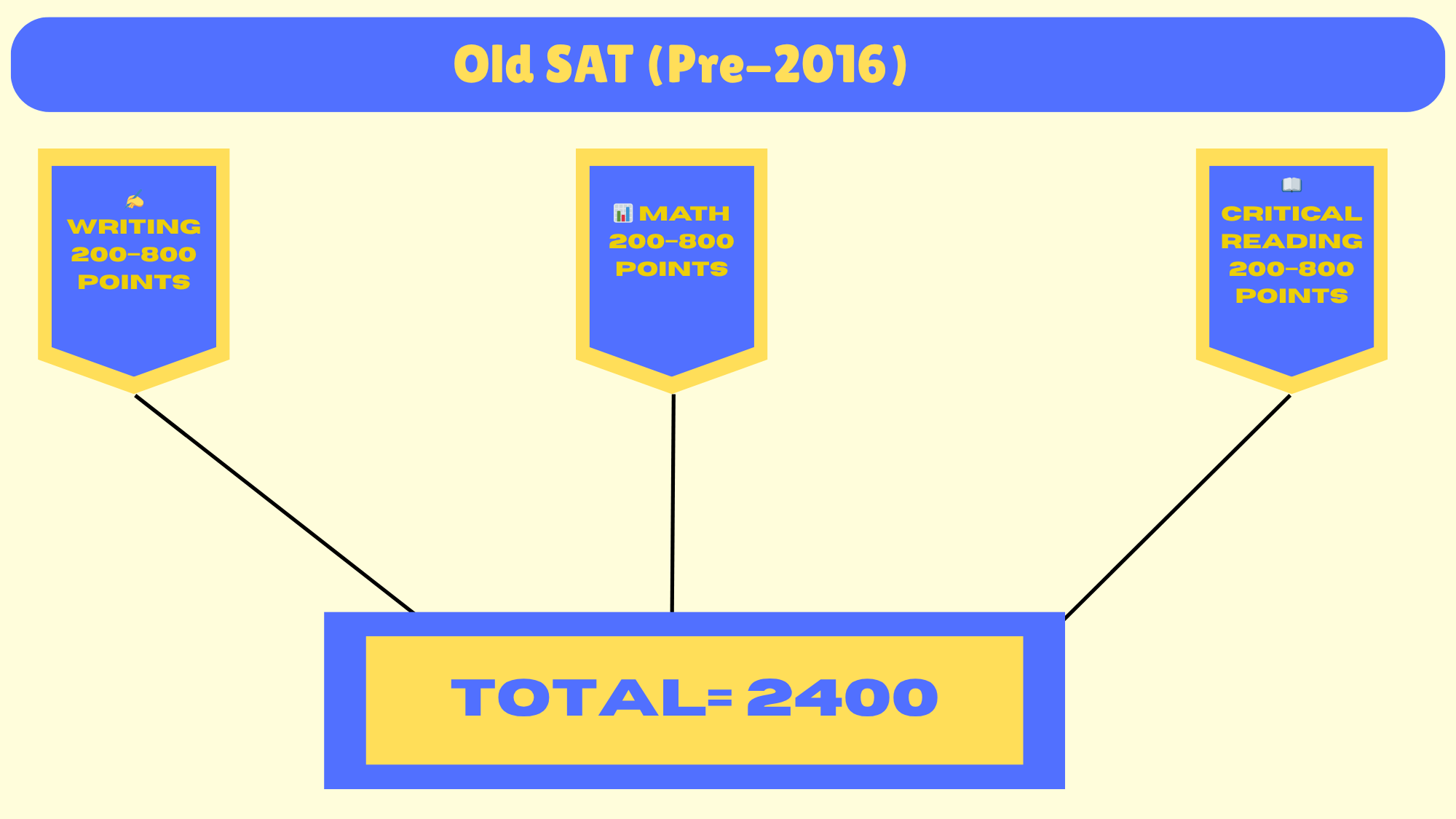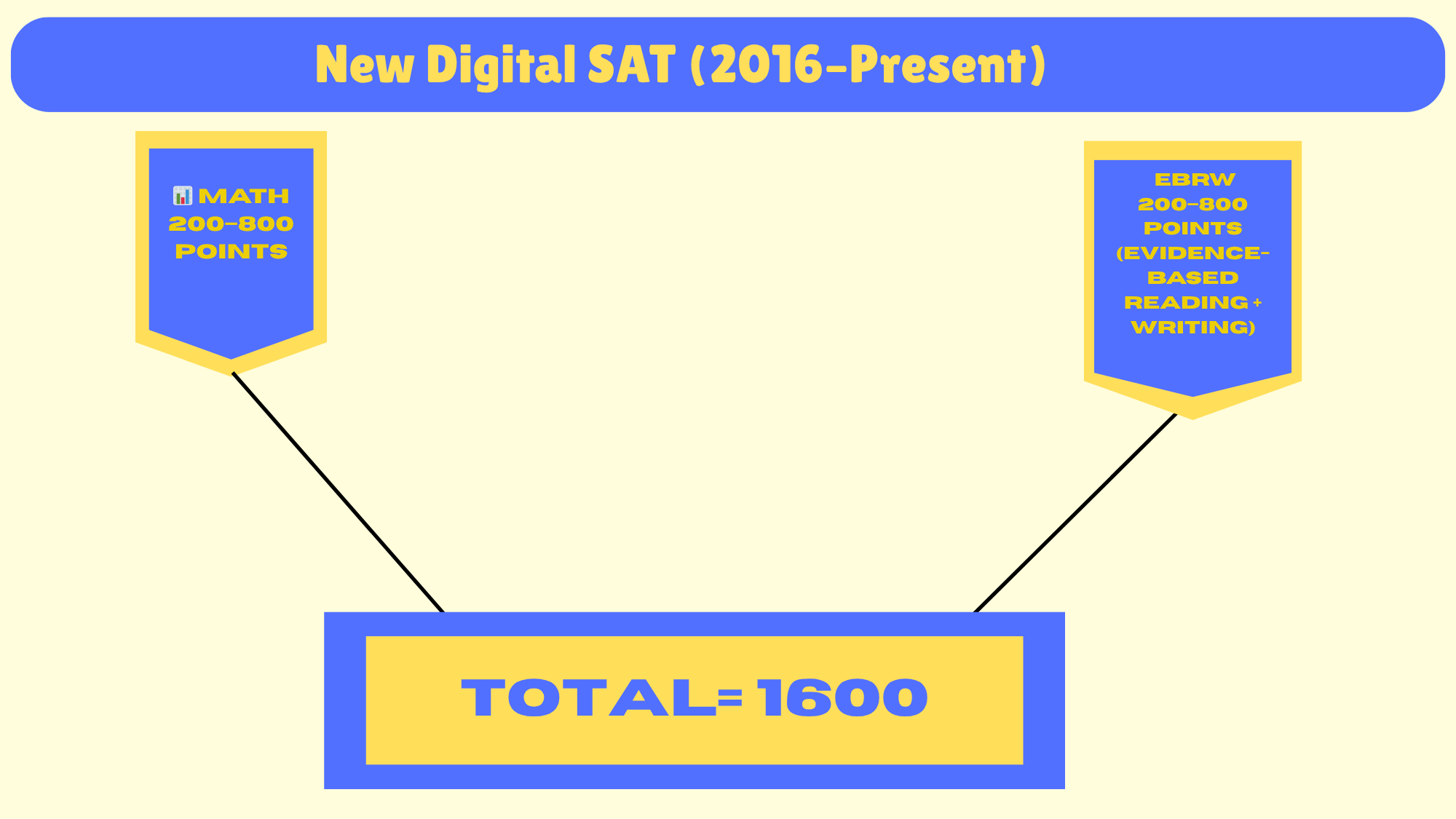In 2016, the College Board made major changes to the SAT, marking the most significant updates since 2005. The scoring system was changed from a 2400-point scale back to the familiar 1600-point scale.
In the old SAT an essay was required for the Writing section, and each component was equally important in calculating a student’s final grade.
This format was created to assess math problem-solving skills, vocabulary, grammar, and reading comprehension.
Now, in contrast to the new SAT introduced, in many administrations, the essay portion was eventually phased out completely and made optional.
Command of the evidence, contextually relevant vocabulary, data interpretation, and algebraic reasoning are all given more weight in the updated test.
Major Changes Include
The SAT has undergone significant changes over the years, most notably in 2016 when it shifted from a 2400-point scale to a 1600-point format.
- Separate Writing section was no longer required. The new format included only two main sections: Evidence-Based Reading and Writing and Math.
- The essay became optional, and the test removed the penalty for wrong answers, which had previously taken away a quarter point for incorrect responses.
- The vocabulary changed from obscure words to more common terms used in academic and professional settings.
The changes in SAT have certainly emphasized skills that are more relevant to college coursework.
Understanding SAT Scoring Formulas
Understanding the SAT scoring formulas is important as it plays a crucial role in your preparation schedule.
-
Total Score: Ranges from 400 to 1600. This is the sum of your Math and Evidence-Based Reading and Writing section scores.
-
Section Scores: Each of the two main sections (Math, Reading, and Writing) is scored on a scale from 200 to 800.
-
Test Scores: These reflect your performance on the Reading, Writing, Language, and Math tests separately, each reported on a scale from 10 to 40.
-
Cross-Test Scores: Reported on scales of 10–40, these highlight performance in Analysis in History/Social Studies and Analysis in Science, based on relevant questions across the sections.
-
Subscores: These are detailed breakdowns of specific skills, such as Expression of Ideas or Heart of Algebra, but they are not part of the main reported score.
How Has this Helped Candidates?
This new format has significantly helped the students as well as the administration to reduce confusion, as now it has become easier to track progress and compare scores.
Additionally, official concordance tables allow those with older scores to fairly convert and present their results for scholarships or college applications, ensuring equity across test versions.
Step-By-Step Guide to Convert Scores
Below is a tutorial on how to convert your old SAT scores to New SAT scores.
Step 1: Identify Your Old SAT Sections
- Locate your Math score (200-800)
- Find your Critical Reading score (200-800)
- Note your Writing score (200-800)
Step 2: Combine Reading and Writing
- Add Critical Reading + Writing scores together
- This gives you your combined Reading/Writing raw total
- Example: 650 (Reading) + 600 (Writing) = 1250
Step 3: Convert Combined Score to New EBRW Scale
- Use the College Board’s concordance table
- The combined 1250 converts to approximately 640 EBRW
- Note: This isn’t a simple division – use official conversion tables
Step 4: Keep Math Score As-Is
- Your old Math score directly transfers to the new format
- Example: 720 Math remains 720 Math
Step 5: Calculate New Total
- Add converted EBRW + Math scores
- Example: 640 (EBRW) + 720 (Math) = 1360 total
(TOOL TO BE USED)
Old SAT Structure V/S New SAT Structure.
Below is a detailed comparison of the old SAT structure and the new SAT structure.
OLD SAT (2016)
The previous SAT consisted of Writing, Maths, and Critical Reading sections, each allocated 200-800 points, with a 1/4 guessing penalty.

NEW DIGITAL SAT
The new digital SAT, introduced after 2016, includes only Maths and evidence-based reading and writing. This even includes no guessing penalty.

Evidence-Based Reading and Writing
This section tests how well you understand, analyze, and edit written English.
Sections:
- 65-minute Reading section
- 35-minute Writing and Language section
Questions:
- 52 Questions (Reading)
- 44 Questions (Writing and Language)
Score Range: 200–800
Math
This section measures your ability to solve problems using mathematical concepts and reasoning.
Sections:
- 25-minute No Calculator section
- 55-minute Calculator section
Questions:
- 20 Questions (No Calculator)
- 38 Questions (Calculator)
Score Range: 200–800
Conversion Table
Here Is the Official SAT Composite Score Conversion Chart for Your Reference: Click Here
When and Why Should You Convert Your SAT Scores?
Converting your old SAT to the new SAT scale can boost your college application strategy and ensure your efforts are understood in today’s admissions landscape.
When Should You Convert Your Scores?
Below are some points that explain in as to when you should convert your SAT scores.
- If you are a college student and have been actively applying for college applications, you should convert your scores. This is because most U.S. colleges use the new SAT scale for admissions, and converting scores can help the college interpret them easily.
- Converting scores also helps you if you need to compare them, as this comparison allows you to compare your old and new scores.
- Converting scores is also essential for scholarships or cutoff programs, as your converted scores can accurately correspond and determine your eligibility for the scheme.
Why Should You Convert Your Scores?
The given points explain to us why one should convert their old SAT scores to new SAT scores.
- It is beneficial for fair comparison because the Old SAT and New SAT have different parameters that affect your marks.
- Because the new SAT format sometimes slightly inflates scores compared to the old version, conversion can present your results in the best possible light.
- It will give a thorough raise to your percentile as the conversion table links your performance directly to the percentiles.
Frequently Asked Questions
Is a Perfect 2400 Old Sat Equal to 1600 on the New Sat?
Yes, perfect old = perfect new. Both translate to the 99th percentile
Does the Digital Sat Change Affect Concordance?
No, the SAT remains on the 1600 scale; official tables still apply.
Are Converted Scores Valid as Native Scores?
Colleges prefer actual scores from the format you took. You should use conversions only when necessary for understanding context.












